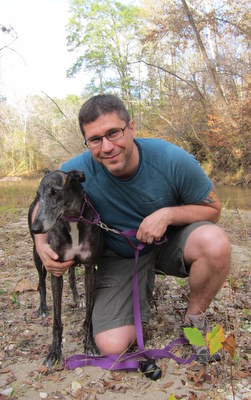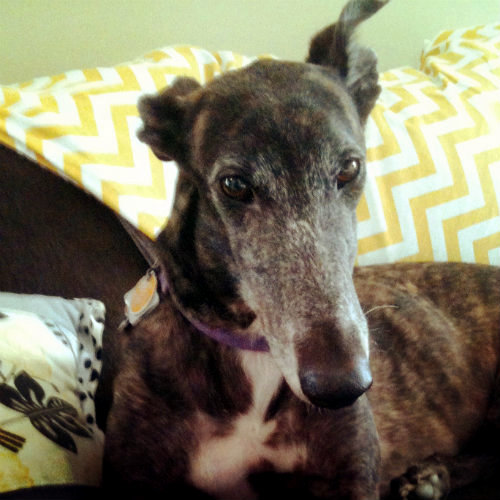
Christy Lorio (photo by Leslie Almeida)
There’s an old joke that eventually, people start to resemble their dogs. I got a greyhound about two years ago, and while I’m still waiting to be tall and skinny like her, I’ve grown content to share personality traits with my retired athlete instead: We both like long walks, yogurt, and hogging space in the bed.
But we weren’t always BFF. Greyhounds are a special breed, akin to adopting a cranky teenager with a built-in lifetime of bad habits. They’re timid, afraid, and might come from an abusive environment depending on the former owner. The dogs typically race until they’re 3 to 5 years old, then are retired from the tracks. Imagine being holed up in a room all day, only let out to run. When we first got our needlenose, she had never gone up and down a flight of stairs and was deathly afraid of the dishwasher. Other dogs frightened her, unless she saw another greyhound, which was akin to watching long lost lovers embrace.
Since that rocky start, she’s proven to be a great dog, one that is low maintenance, quiet (they rarely bark), and well behaved. But there are a few things you need to know before bringing your own 30-mph couch potato home:

The author’s two significant others.
– Secure everything. When you’ve got a dog that can run 30-40 mph, having a secure home is key. While a yard isn’t a necessity, make sure your dog can’t get out. Accidentally leaving the front door open can result in a lost dog before you even realize it’s gone. When our foster family came over, we got a full inspection of the yard and house to ensure we wouldn’t have to worry about an escape artist.
– Be patient. Don’t expect a cuddle monster that rolls around playing fetch with you. Nadia would rather hold down the couch than play ball. Every year their personalities open up a little bit more. Now instead of only being aloof, she’s goofy and excitable when you utter the magic word “outside”.
– Thin is in. Remember, your dog is supposed to be thin. After all, they are bred for speed. Since greyhounds can’t regulate their body temperature as well as a canine with more meat on its bones, keeping them inside is an absolute necessity. A comfortable dog bed is a good investment, although mine prefers the couch.
– Good food. Greyhounds need a high protein diet. Skimp on this and you’ll have a nonstop fart factory on your hands. I made the switch from Blue Buffalo to Blue Buffalo Wilderness with extra protein and we are now living stink free.
– Don’t be disappointed. Nadia doesn’t play like regular dogs, except for when she gets riled up. Toys? She’s too aloof for that nonsense. But come home from a long day at work, and she gets so excited to see me she takes off running in the house like she’s at the track again.
I highly recommend reading Greyhounds for Dummies before you bring your pooch home. It covers a lot of ground, and provides you with a realistic expectations for your former track star.
Adoption resources:
http://www.houndsabound.org/
http://www.itsagreyarea.com/
http://www.gulfcoastgreyhounds.org/
Christy Lorio, a native New Orleanian, writes on fashion at slowsouthernstyle.com and is also a freelance writer whose work has been featured online and in print magazines both locally and nationally.

That’s one pretty bitch. And suuure, blame Nadia for the poots.
Now that her flatulence is in check, it gets harder and harder to blame it on the dog.
If you’re not in our area, here’s a great site to find your nearest greyhound rescue:
http://www.adopt-a-greyhound.org/
I appreciate the article and the promotion of greyhound adoption and the overall advice of the oddities of owning a greyhound, but I have a few comments:
Most greyhounds are not timid, afraid or abused. Most walk out of the kennel and into foster homes with tails wagging, happy, giving kisses and ready to go. Shy behaviors do not come from abuse, but from certain breeding lines that tend to produce more reserved dogs. At the racetrack, they are kenneled, but have several outside breaks a day, just like a dog at home would. As you find out having one at home, they sleep A LOT. The kennels are large enough for the dogs to stand up, turn around and stretch out. Even after adoption, many like the personal space that having their own kennel offers. There are a lot of things they have not experienced, such as stairs, glass doors, loud machines and so on. They may be startled or confused by these things at first, but that is only because they grew up on a farm with no stairs, no tv, etc., so they have just never seen these things. Many greyhounds will play fetch, play with toys, think they are lap dogs and have never met a stranger. All of mine sleep with us and love snuggling on the couch. Point being, they all have different personalities, just like people do. How they are raised, trained and race have a huge impact on them being such wonderful, loving dogs. Brittaney Spruill Vice Preisdent It’s a Grey Area Greyhound Adoption
Y’all make a very cute and lovable pack…
The very best from across Freret Street.
Andy and Kellie
I too had a rescued greyhound. We named him “Beau-the-bad-bane-of-all-bunnies” or Beau for short. He was a total gentleman and I still miss him.
Nadia is beautiful. Thank you for this common sense article on living with a greyhound. It is no surprise that ex-racing dogs need to be shown the ropes about life in the real world.
Greyhound racing is cruel and inhumane. Greyhounds endure lives of nearly constant confinement, kept in cages barely large enough for them to stand up or turn around. While racing, many dogs suffer and die from injuries including broken legs, paralysis, and cardiac arrest. And many greyhounds are euthanized every year, as the number retired from racing exceeds the number of adoptive homes.
At racetracks across the country, greyhounds endure lives of confinement. According to industry statements, greyhounds are generally confined in their cages for approximately 20 hours per day. They live inside warehouse-style kennels in stacked cages that are barely large enough to stand up or turn around. Generally, shredded paper or carpet remnants are used as bedding.
An undercover video recently released by GREY2K USA shows the conditions in which these gentle dogs are forced to live: http://www.grey2kusa.org/azVideo.html
For more information on injuries these dogs suffer, please view:
http://www.grey2kusa.org/azInjuries.html
http://www.grey2kusa.org/eNEWS/G2K-022811Email.html
Dogs play an important role in our lives and deserve to be protected from industries and individuals that do them harm.
V Wolf Board Member, GREY2K USA